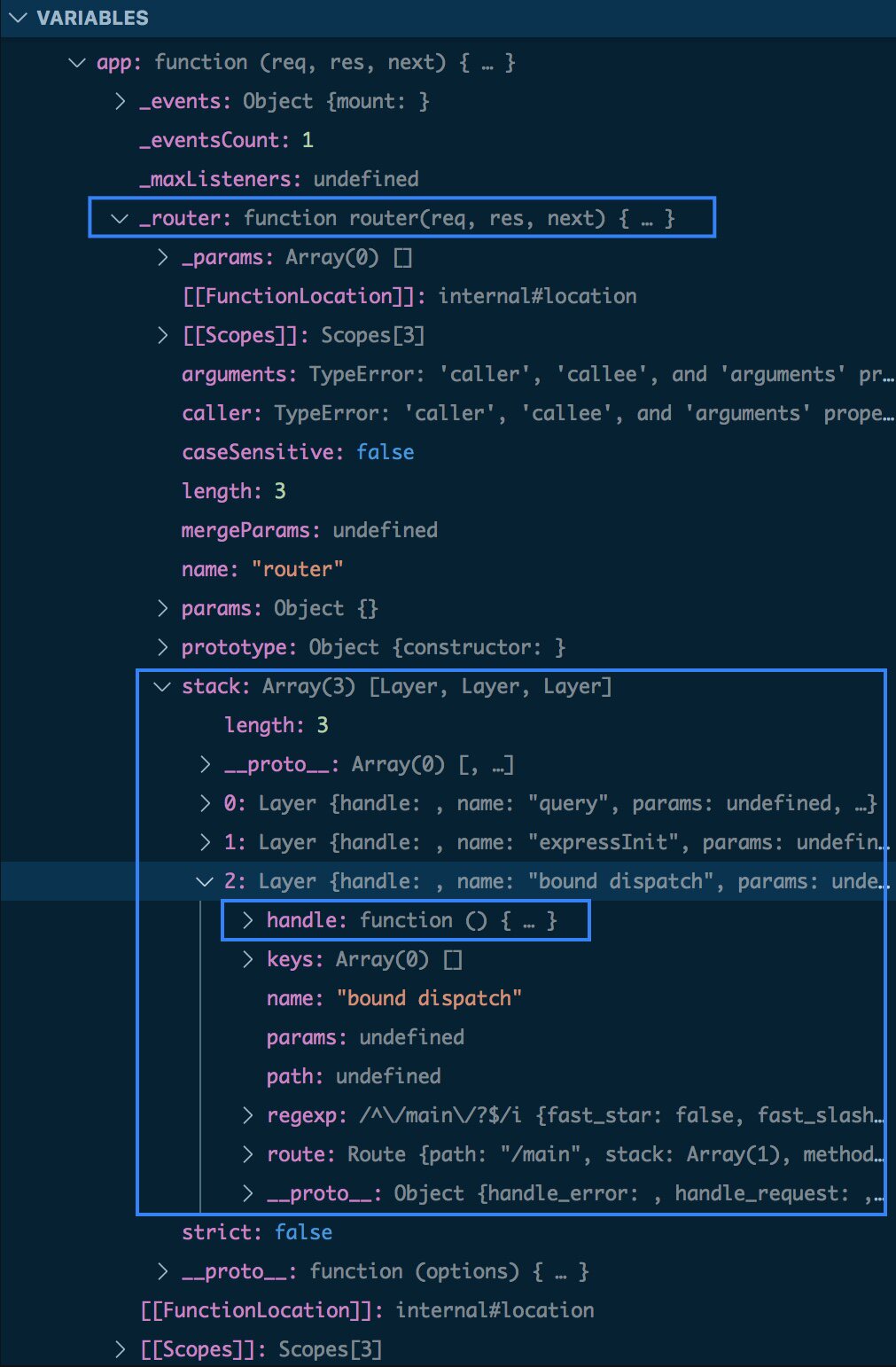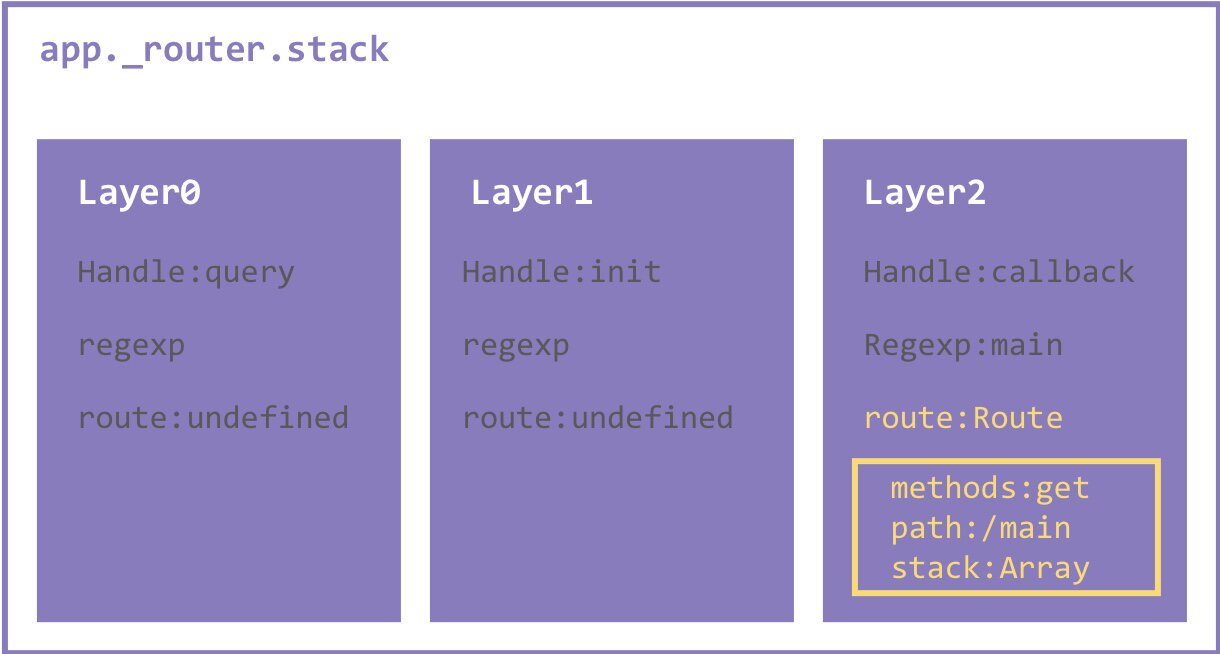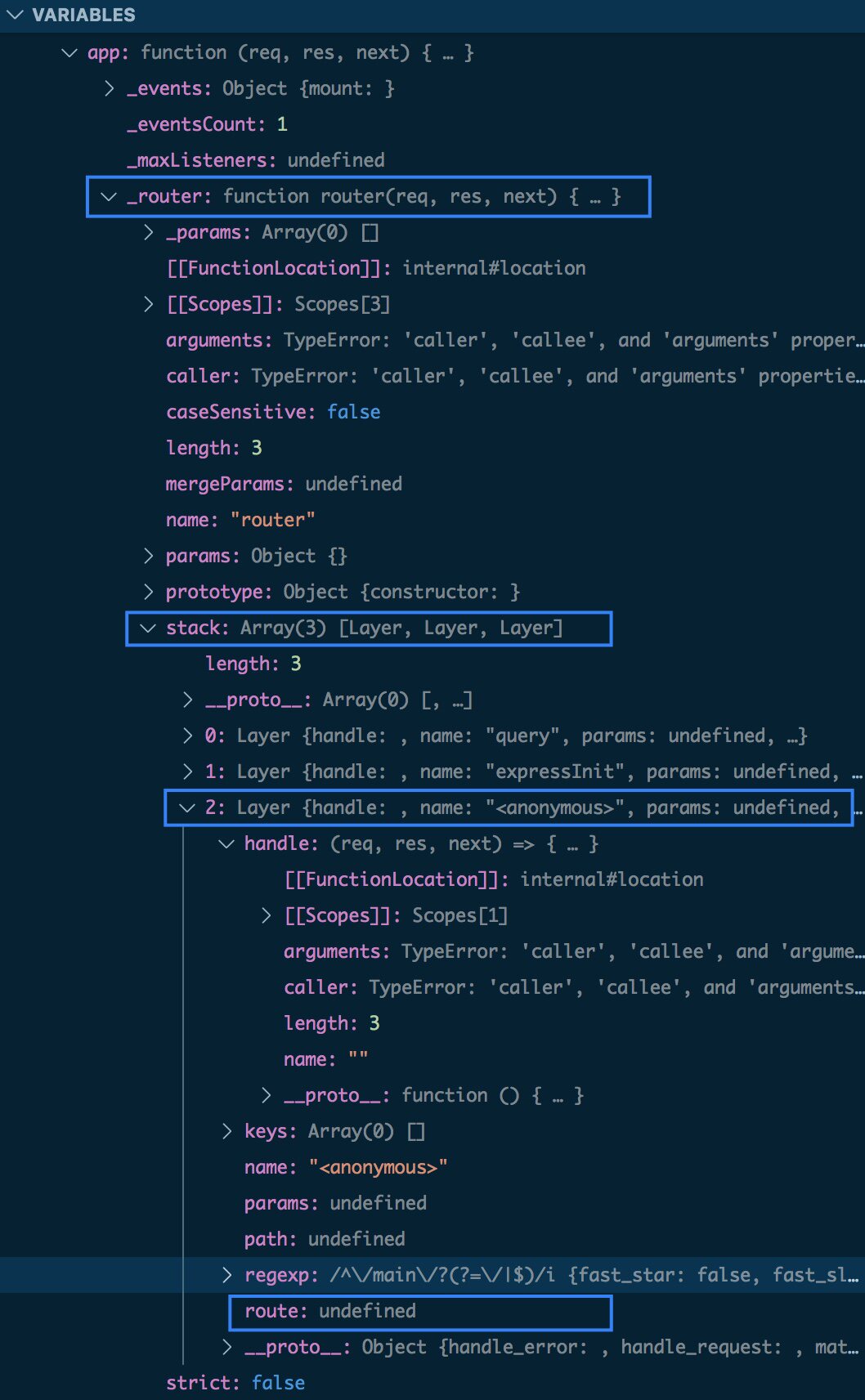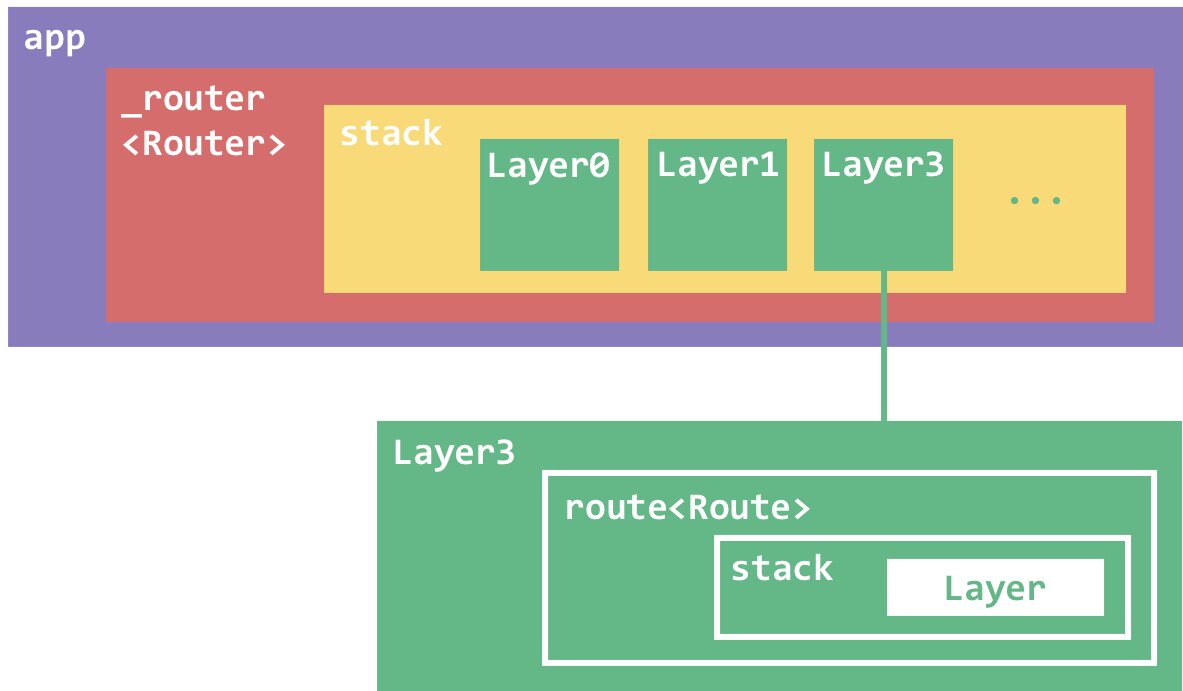Express 是一种保持最低程度规模的灵活 Node.js Web 应用程序框架,为 Web 和移动应用程序提供一组强大的功能。本文针对该框架进行一些简单的源码解读。
Express中的app
1
2
3
4
5
6
7
8
9
10
11
12
13
14
15
16
17
18
|
function createApplication() {
var app = function(req, res, next) {
app.handle(req, res, next);
};
mixin(app, EventEmitter.prototype, false);
mixin(app, proto, false);
app.request = Object.create(req, { ... });
app.response = Object.create(res, { ... });
app.init();
return app;
}
exports = module.exports = createApplication;
|
可以看出,调用express()返回的app其实是一个函数,调用app.listen()其实执行的是http.createServer(app).listen()。因此,app其实就是一个请求处理函数,作为http.createServer的参数。而express其实是一个工厂函数,用来生成请求处理函数。
中间件
An Express application is essentially a series of middleware calls.
一个Express应用实际上就是一系列中间件的调用。
中间件大致可分为两种,一种是普通中间件,通过 app.use('/user') 方法进行注册,该方法中的路径是匹配所有以 /user 开头的路径;另外一种是路由中间件,通过 app.METHOD() 方法进行注册,这种方式精确匹配路径,且只能处理确定请求方法的请求。
针对app.use部分的代码如下:
1
2
3
4
5
6
7
8
9
10
11
12
13
14
15
16
17
18
19
20
21
22
23
24
25
26
27
28
29
30
31
32
33
34
35
36
37
38
39
40
41
42
43
44
45
46
| app.use = function use(fn) {
var offset = 0;
var path = '/';
if (typeof fn !== 'function') {
var arg = fn;
while (Array.isArray(arg) && arg.length !== 0) {
arg = arg[0];
}
if (typeof arg !== 'function') {
offset = 1;
path = fn;
}
}
this.lazyrouter();
var router = this._router;
var fns = flatten(slice.call(arguments, offset));
fns.forEach(function (fn) {
if (!fn || !fn.handle || !fn.set) {
return router.use(path, fn);
}
debug('.use app under %s', path);
fn.mountpath = path;
fn.parent = this;
router.use(path, function mounted_app(req, res, next) {
var orig = req.app;
fn.handle(req, res, function (err) {
setPrototypeOf(req, orig.request)
setPrototypeOf(res, orig.response)
next(err);
});
});
fn.emit('mount', this);
}, this);
return this;
};
|
针对app.METHODS的代码如下:
1
2
3
4
5
6
7
8
9
10
11
12
13
14
| methods.forEach(function(method){
app[method] = function(path){
if (method === 'get' && arguments.length === 1) {
return this.set(path);
}
this.lazyrouter();
var route = this._router.route(path);
route[method].apply(route, slice.call(arguments, 1));
return this;
};
});
|
路由详解
在上面两种中间件的实现代码中,都调用了 this.lazyrouter() 方法,所有涉及到路由的方法都会调用这个方法,作用是初始化一个应用的内部路由。
1
2
3
4
5
6
7
8
9
10
11
| app.lazyrouter = function lazyrouter() {
if (!this._router) {
this._router = new Router({
caseSensitive: this.enabled('case sensitive routing'),
strict: this.enabled('strict routing')
});
this._router.use(query(this.get('query parser fn')));
this._router.use(middleware.init(this));
}
};
|
针对第一个默认路由,可以看下具体调用了哪些方法,最终实现了什么逻辑:
1
2
3
4
5
6
7
| this.get('query parser fn');
case 'query parser':
this.set('query parser fn', compileQueryParser(val));
break;
|
针对第二个默认路由 init,是给 app 上的暴露出的 req、res 继承 node 原生的 request 和 response 的一些属性。
之所以不在 defaultConfiguration 方法中进行这一步路由的初始化,原因在于设置路由的相关参数需要调用app.set方法,这个方法明显需要有app实例,如果在获取app实例的时候就初始化了一个路由,这个路由的参数就没办法配置了。因此,在获取app实例后,必须先对路由参数进行配置,然后再调用对应的app.use等方法。
app.Methods
我们先以 app.get 为例,通过断点调试的方式来查看 app.get 这种路由的 _router 对象是什么结构。

上面的截图是当我们初始化一个 express 实例,并设置了一个 app.get() 的路由后,在 app.listen 处添加断点进行调试时的 app 实例的属性。可以看到在 app._router 中有一个 stack,里面按顺存放着三个 layer 对象,分别是初始化时的 query 和 init 两个路由,和第三个则是我们所设置的 get 路由。每一个 layer 中包含路由处理的回调函数 handle,路由对象 route<Route>,该对象中还包含一个存有 Layer 对象的栈(stack),就和 app._router.stack 相同。

根据上面对于 app.get 这种路由的结构分析,我们可以先猜想它的实现流程:
app.use
接下来我们来看 app.use 这种路由又有什么不同。

可以看到,在这种路由中,除了 query 和 init 两个初始化路由的方法外,第三个真正的回调方法被封装成的 Layer 对象中,route 属性的值为 undefined。
所以我们可以猜想:在 app.use 这种路由里,传入的参数(路径、回调函数)会被封装成 Layer 对象(其中 route 属性为 undefined),压入 app._router.stack 栈中。
两种路由的源码实现
接下来我们通过源码来分析我们写的 app.use('/main', someFun()) 是如何成为一个 layer 对象并压入 app._router 的路由栈中的。
首先来看 app.use:
1
2
3
4
5
6
7
8
9
10
11
12
13
14
15
16
17
18
| app.use = function use(fn) {
var path = '/';
this.lazyrouter();
var router = this._router;
fns.forEach(function (fn) {
router.use(path, function mounted_app(req, res, next) {
});
});
}, this);
return this;
};
|
接下来看 Router 对象的 use 方法实现:
1
2
3
4
5
6
7
8
9
10
11
12
13
14
15
16
17
| proto.use = function use(fn) {
var path = '/';
var callbacks = flatten(slice.call(arguments, offset));
for (var i = 0; i < callbacks.length; i++) {
var fn = callbacks[i];
var layer = new Layer(path, {
sensitive: this.caseSensitive,
strict: false,
end: false
}, fn);
layer.route = undefined;
this.stack.push(layer);
}
return this;
};
|
从代码中可以看到,与我们的猜想一致,app.use 这种路由的实现,是将传入的一个个路径或回调方法等参数封装成 Layer 对象压入 _router.stack 栈中。
然后来看 app.get 这种路由的代码实现:
1
2
3
4
5
6
7
8
9
10
11
12
13
14
|
methods.forEach(function(method){
app[method] = function(path){
if (method === 'get' && arguments.length === 1) {
return this.set(path);
}
this.lazyrouter();
var route = this._router.route(path);
route[method].apply(route, slice.call(arguments, 1));
return this;
};
});
|
上面代码中最终返回的是 app,那么这端代码对 app 进行了什么样的操作呢?我们可以将目光聚焦在 route[method].apply() 这行代码上。接下来我们可以看下 route 到底是个什么东西。this._router.route 的代码实现:
1
2
3
4
5
6
7
8
9
10
11
12
13
14
| proto.route = function route(path) {
var route = new Route(path);
var layer = new Layer(path, {
sensitive: this.caseSensitive,
strict: this.strict,
end: true
}, route.dispatch.bind(route));
layer.route = route;
this.stack.push(layer);
return route;
};
|
这里可以看到返回的 route 是一个 Route 对象,在这个对象中将参数封装成了 Layer 对象推入了 app._router.stack 中。
接下来我们看一下 Route 对象中的一些实现代码:
1
2
3
4
5
6
7
8
9
10
11
12
13
14
15
16
17
18
19
20
21
22
23
| function Route(path) {
this.path = path;
this.stack = [];
this.methods = {};
}
methods.forEach(function(method){
Route.prototype[method] = function(){
var handles = flatten(slice.call(arguments));
for (var i = 0; i < handles.length; i++) {
var layer = Layer('/', {}, handle);
layer.method = method;
this.methods[method] = true;
this.stack.push(layer);
}
return this;
};
});
|
至此,在调用 route[method].apply() 时就会为 app.METHODS 这种类型的路由的 Layer 中添加 route<Route> 属性。




